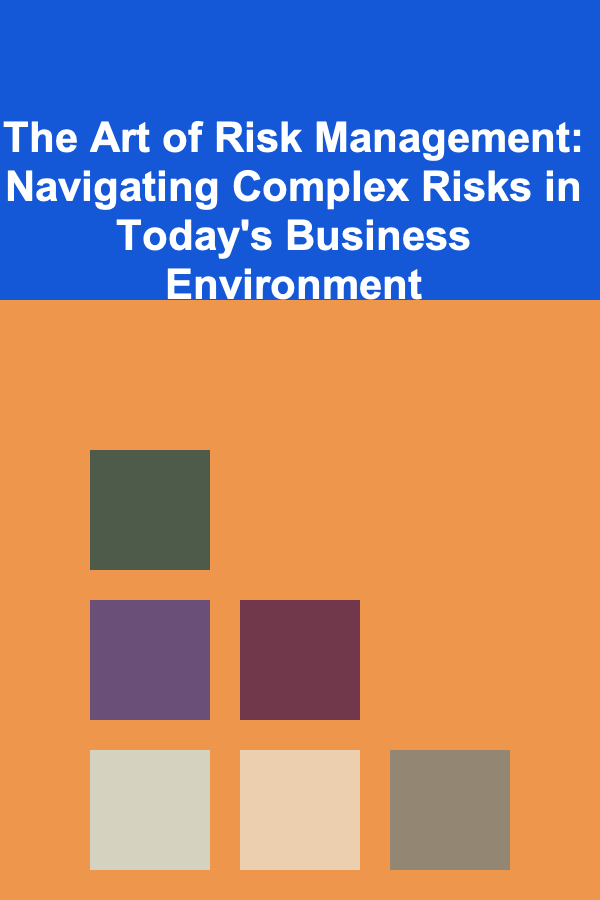
The Art of Risk Management: Navigating Complex Risks in Today's Business Environment
ebook include PDF & Audio bundle (Micro Guide)
$12.99$7.99
Limited Time Offer! Order within the next:

In today's fast-paced and interconnected world, businesses face an ever-increasing array of risks. The landscape has evolved, and traditional methods of managing risks are no longer sufficient. A business must have a comprehensive, proactive, and dynamic approach to managing risks to survive and thrive. This requires a deep understanding of the various types of risks and an effective strategy for managing them.
In this article, we'll explore the art of risk management in today's business environment, identifying key types of risks, strategies for mitigating them, and the best practices that organizations can adopt to navigate complex risks successfully.
Understanding Modern Business Risks
Risk, in the context of business, is the possibility of a negative outcome resulting from various factors. Modern businesses are exposed to more diverse and interconnected risks than ever before, stemming from internal operations, external forces, or a combination of both. These risks are categorized broadly into several types, including strategic, financial, operational, compliance, and reputational risks.
1. Strategic Risks
Strategic risks are related to the decisions made by a company at the top level, such as entering a new market, launching a new product, or shifting business models. These decisions carry the possibility of failure and can significantly impact the company's long-term success. The risk here is primarily associated with misaligned strategies, market changes, or poor execution of strategic initiatives.
2. Financial Risks
Financial risks pertain to the fluctuations in market conditions that can affect a company's ability to meet its financial obligations or impact its financial performance. This includes currency fluctuations, changes in interest rates, and liquidity issues, along with risks related to financial market instability. These can also extend to risks involving credit, investments, and business financing structures.
3. Operational Risks
These risks stem from the internal operations of the business, which includes everything from supply chain disruptions to cyberattacks. Operational risks are typically related to people, processes, and technology failures. In today's highly digitalized business world, cybersecurity threats have become a key operational risk. These risks can be hard to predict, but they have the potential to disrupt day-to-day operations and harm a company's bottom line.
4. Compliance Risks
With increasing regulatory requirements and a rapidly changing legal environment, compliance risks have become more complex. Companies must ensure that they adhere to local, national, and international laws, as well as industry standards. Failing to comply with regulations can lead to heavy fines, legal consequences, and damage to a company's reputation.
5. Reputational Risks
Reputational risk is an often intangible yet profoundly impactful risk. The reputation of a business is one of its most valuable assets, and damage to this asset can result in lost customers, investors, and opportunities. Reputation risks can arise from a wide variety of sources, including product failures, unethical practices, social media crises, and more.
The Evolving Nature of Risks in the Business Landscape
The complexity of business risks has evolved due to several factors:
- Globalization: The increased interconnectedness of markets and industries means that risks can spread rapidly across borders. A financial crisis in one country can have ripple effects across the globe, and a supply chain disruption in one part of the world can affect production schedules worldwide.
- Technology and Cybersecurity: As businesses rely more on technology, they become increasingly vulnerable to cyberattacks and technological disruptions. The rise of artificial intelligence, machine learning, and automation, while offering immense potential, also introduces new forms of risk that require specialized management.
- Changing Consumer Expectations: With social media and online platforms, customers now have an amplified voice. A single negative tweet or a viral video can spark a crisis, leading to a massive reputational risk. Consumers expect transparency, ethical behavior, and corporate responsibility, making it necessary for businesses to carefully manage how they engage with their audience.
- Climate and Environmental Risks: As environmental issues and climate change rise to the forefront, businesses are becoming increasingly aware of the physical and regulatory risks associated with the environment. Climate risks can range from physical damage to assets due to extreme weather events to changes in government regulations requiring more sustainable practices.
Developing a Robust Risk Management Framework
To navigate the complex landscape of business risks, companies must develop a structured, proactive risk management framework. This framework should not be static but flexible, allowing companies to adapt to changing circumstances.
1. Risk Identification
The first step in any effective risk management strategy is to identify potential risks. This involves examining both external and internal factors that could potentially harm the business. Risk identification should be an ongoing process and involve stakeholders from different levels of the organization, ensuring that both the macro and micro-level risks are accounted for.
Methods for Risk Identification:
- Brainstorming: Gathering key stakeholders and discussing potential risks.
- SWOT Analysis: Identifying strengths, weaknesses, opportunities, and threats in the business environment.
- Scenario Planning: Imagining various worst-case scenarios and considering how they could affect the business.
- Risk Audits: Conducting audits and assessments of current processes and policies to uncover potential vulnerabilities.
2. Risk Assessment
Once risks have been identified, businesses must assess the severity and likelihood of each risk. This step is critical because not all risks are equal. Some risks may be relatively low in probability but carry significant consequences, while others may occur frequently but have only minor impacts.
Risk Assessment Methods:
- Qualitative Risk Assessment: Rating risks based on qualitative factors like impact severity (high, medium, low).
- Quantitative Risk Assessment: Using data to calculate the probability and financial impact of a risk.
3. Risk Mitigation Strategies
Mitigating risks involves developing strategies that either reduce the likelihood of a risk occurring or reduce its impact if it does. Businesses should prioritize risks that pose the greatest threat to the organization's survival or objectives.
Risk Mitigation Approaches:
- Risk Avoidance: Taking steps to avoid situations or activities that carry high levels of risk.
- Risk Reduction: Implementing controls to reduce the probability or impact of the risk. For example, improving cybersecurity measures or diversifying the supply chain.
- Risk Transfer: Using insurance or outsourcing to transfer the financial burden of certain risks to third parties.
- Risk Acceptance: Sometimes, the best option is to accept certain risks, especially if they are low in probability or cost. However, businesses should always have contingency plans in place in case these risks materialize.
4. Monitoring and Review
Risk management is an ongoing process that requires regular monitoring and review. As new risks emerge and existing ones evolve, businesses must continuously assess their risk environment and adjust their strategies accordingly.
Methods for Continuous Monitoring:
- Key Risk Indicators (KRIs): These are metrics that help businesses monitor potential risks. For example, a drop in customer satisfaction might be an early indicator of reputational risk.
- Internal Audits: Regular internal audits allow businesses to assess compliance with risk management policies and uncover new risks.
- Stakeholder Feedback: Engaging with employees, customers, and other stakeholders provides valuable insights into potential emerging risks.
Building a Risk-Aware Culture
A critical part of managing risks successfully is embedding a risk-aware culture throughout the organization. When everyone from top leadership to entry-level employees understands the risks facing the company and is trained to respond appropriately, businesses are better prepared to handle challenges.
Key elements of a risk-aware culture include:
- Leadership Commitment: Senior management must lead by example and demonstrate a commitment to risk management.
- Employee Training: Regular training sessions on risk management should be part of employee development.
- Clear Communication: A transparent communication strategy ensures that risks are reported and addressed in a timely manner.
Conclusion
In an increasingly volatile, uncertain, complex, and ambiguous world, the art of risk management is more important than ever. Businesses need to take a strategic, proactive approach to identifying, assessing, and mitigating risks. By doing so, they not only protect themselves from potential threats but also position themselves to capitalize on opportunities and achieve long-term success.
The key is to understand that risk is inherent in every aspect of business and must be managed continuously with a mindset that blends caution with innovation. By adopting a comprehensive risk management framework, fostering a culture of risk awareness, and maintaining agility in the face of change, businesses can navigate today's complex risks and thrive in the face of uncertainty.

How to Clean Your Ice Maker for Best Results
Read More
How to Create a Comprehensive Checklist for Content Promotion
Read More
How to Find Your Purpose for Mental Fulfillment
Read More
How to Open an Account with National Bank of Canada Brokerage
Read More
How to Organize Your Luxury Travel Wardrobe
Read More
How to Soundproof a Child's Room for Quieter Play
Read MoreOther Products

How to Clean Your Ice Maker for Best Results
Read More
How to Create a Comprehensive Checklist for Content Promotion
Read More
How to Find Your Purpose for Mental Fulfillment
Read More
How to Open an Account with National Bank of Canada Brokerage
Read More
How to Organize Your Luxury Travel Wardrobe
Read More